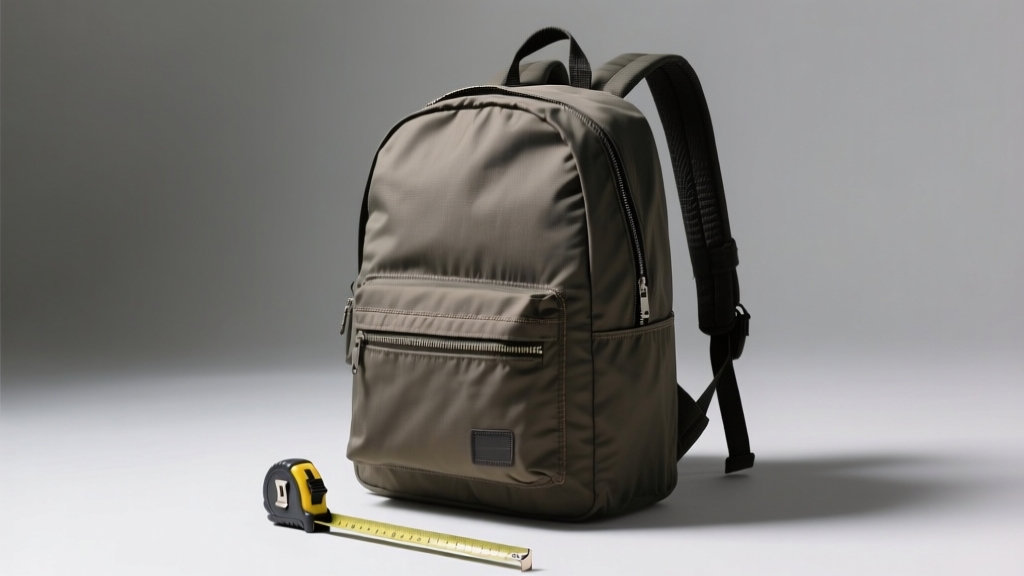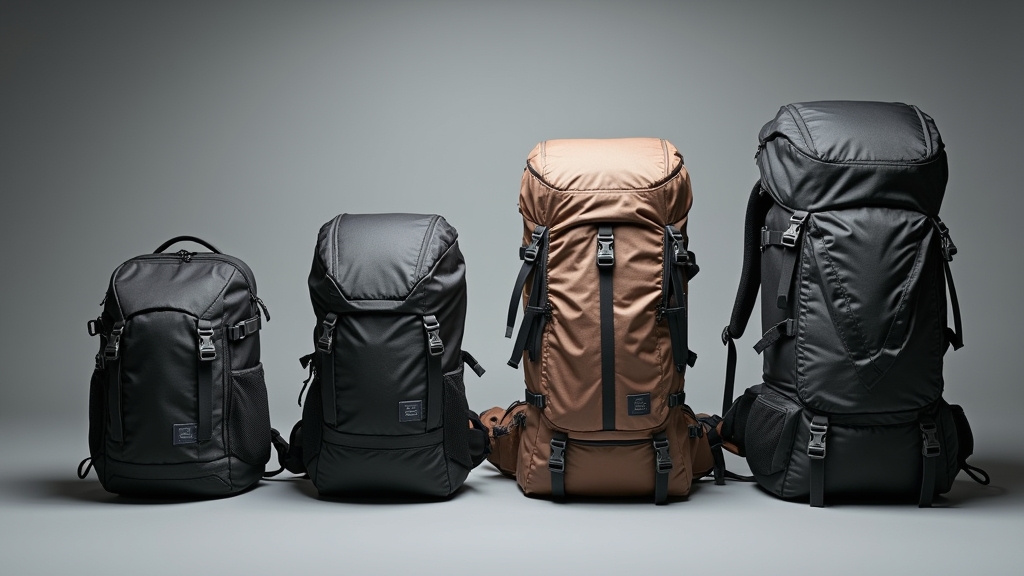
A standard backpack usually measures about 16 to 22 inches tall, 11 to 14 inches wide, and 8 to 9 inches deep. This size generally holds between 15 and 45 liters, depending on whether it’s meant for daily use, school, or short trips.
To get the best fit, you need to measure your torso length and hip circumference precisely. These dimensions suit most users, but exploring variations for specific activities and better comfort could enhance your choice.
Key Takeaways
- Standard backpacks for daily use typically measure around 16″x11″x8.5″ with a volume of 15 to 24 liters.
- Carry-on backpacks usually have dimensions near 22″x14″x9″ and a capacity of about 45 liters.
- Medium backpacks range from 24 to 35 liters and fit laptops up to 15 inches, with corresponding size adjustments.
- Large backpacks start around 30 liters and can exceed 50 liters for extended trips, with bigger physical dimensions.
- Backpack size is measured by volume in liters, not just physical dimensions, aligning with intended use and gear capacity.
Standard Backpack Size Classifications

How do you choose the right backpack size for your needs? Start by identifying your typical use cases and gear requirements.
Begin by assessing your usual activities and the gear you need to carry.
Small backpacks, under 19 liters, suit minimal gear for day trips or quick errands, offering lightweight, compact storage. These are often preferred by individuals with smaller body frames for enhanced comfort.
Medium backpacks, ranging from 20 to 29 liters, balance capacity and portability for school, work, or commuting, fitting laptops, books, and modest extras. Choosing materials with durability characteristics can influence the backpack’s lifespan and performance.
Large backpacks, between 30 and 39 liters, accommodate bulkier items and multi-day trips, including larger laptops and shoes. Extended travel backpacks, sized 40 to 50 liters, support weekend hikes or short vacations with organized packing for multiple days.
Finally, extra-large backpacks exceed 50 liters, designed for extended trips of five or more nights, ideal for professionals and long-distance adventurers needing maximum capacity. Select based on duration, gear volume, and portability demands.
Typical Backpack Dimensions and Volume
Choosing the right backpack size is only part of the equation; understanding the typical dimensions and volume helps guarantee compatibility with your travel or daily needs.
Most backpacks fall within specific volume ranges that suit various activities and storage requirements, and measuring overall size including any protruding parts like straps is important for travel compliance.
Carry-on backpacks typically measure 22″x14″x9″, holding about 45 liters, fitting airline carry-on limits without checked baggage. It is important to remember that volume indicates storage capacity in liters, not physical size, which affects how much you can carry.
Daypacks and small backpacks range from 15 to 24 liters (915 to 1,465 cubic inches), with dimensions around 16″x11″x8.5″. Medium backpacks offer 24 to 35 liters capacity, designed to accommodate tablets and laptops up to 15 inches.
Knowing these details guarantees you select a backpack that fits your gear and complies with travel size restrictions.
Measuring for Proper Backpack Fit
Although selecting the right backpack volume is essential, measuring your torso and hip dimensions accurately guarantees a proper fit that maximizes comfort and weight distribution.
Start by locating your C7 vertebra, the prominent bump at your neck base with your head neutral. Use a flexible tape measure from C7 down your spine’s natural curve to the iliac crest, found by aligning your thumbs on your hip bones and creating a straight line across your back.
It is helpful to have a friend or partner assist you during this process to ensure accuracy. Measuring with the backpack zipped and fully packed is also recommended to reflect real use conditions.
Hip circumference measurement wraps the tape over the iliac crest, slightly above your beltline. This measurement is vital since hips bear 80%+ of backpack weight. Enlist help for precise tape placement and compare measurements to standard torso categories.
Select a pack that matches or slightly undercuts your torso length for optimal load transfer and comfort.
Size Variations by Use and Gender
What dimensions matter most when selecting a backpack? Size variations depend heavily on use and gender to guarantee ergonomic support and functionality. Choosing a backpack with adjustable straps and compartments also enhances comfort and organization for different activities.
For example, daypacks range from 15-24 liters and comply with carry-on dimensions (22″ x 14″ x 9″), ideal for daily commuting or travel. Since volume is expressed in liters or cubic inches, it is easier for consumers to understand and compare backpacks based on capacity measurement.
Medium-capacity packs (24-35 liters) suit multi-day trips, adjusting for torso lengths of 45-49 cm and hip widths of 70-87 cm. Large backpacks start at 45 liters, designed for extended expeditions with hip widths up to 100 cm.
Gender-specific designs consider narrower shoulders and different hip placements for women. They also accommodate broader torso and hip dimensions for men. Interchangeable hip belts enable a personalized fit across models.
Understanding these variations helps you choose a backpack tailored precisely to your body and activity. Additionally, selecting ergonomic strap adjustment features ensures a better fit and reduces strain during use.
Common Compartment and Pocket Sizes

How much space do you really need inside a backpack’s compartments and pockets?
For standard carry-on backpacks, the main compartment typically offers around 45 liters of volume, sufficient for essentials and a laptop sleeve about 16″ high and 12″ wide. Many carry-on backpacks also feature compression buckles to stabilize the load and reduce bulk.
Daypacks feature smaller compartments, averaging 15 to 24 liters, with pockets designed for water bottles (7-9″ height) and small accessories. Medium backpacks balance space and organization, providing multiple pockets ranging from 1 to 5 liters each for chargers, notebooks, and snacks.
Extended trip backpacks include large main compartments (45+ liters) with multiple sub-pockets and compression straps, accommodating bulky gear. The Cascade Backpack, for example, offers a versatile 21-liter capacity that fits a 16-inch laptop and includes specialized pockets for organization.
When choosing, focus on compartment volume and pocket dimensions relative to your gear’s size to ensure proper fit and accessibility without wasted space or bulk.
Frequently Asked Questions
How Do Weather Conditions Affect Backpack Material Durability?
Weather conditions directly degrade your backpack’s materials by causing fiber breakdown, seam weakening, and coating failure. UV rays make fabrics brittle and fade colors, while heat accelerates glue and stitch damage.
Moisture promotes mold, weakens fibers, and causes swelling or shrinking, leading to cracks. Abrasive particulates wear down surfaces, and chemical exposure plus freeze-thaw cycles cause microtears and hardware corrosion.
Regular maintenance and protective coatings help preserve your backpack’s durability.
What Are the Best Backpack Brands for Ergonomic Support?
You’ll find Osprey, Deuter, Gregory, The North Face, and Kelty lead in ergonomic support. These brands offer adjustable torso lengths, padded hip belts transferring up to 80% of weight, ventilated back panels, and load lifters that center the load.
Their designs reduce back strain, improve posture, and enhance comfort on long hikes. Look for customizable fits and gender-specific models to match your body perfectly.
How to Clean and Maintain a Standard Backpack Properly?
To clean your backpack, start by emptying all compartments and removing detachable parts. Use a damp cloth with mild soap to wipe the exterior and a soft brush for zippers and seams.
Avoid harsh chemicals and machine washing unless specified. Rinse treated spots with clean water, then air dry in shade. Maintain your pack by inspecting for damage, storing it dry, avoiding overpacking, and applying fabric protectants as recommended.
Are There Eco-Friendly Materials Used in Backpack Manufacturing?
Yes, you’ll find eco-friendly materials in many backpacks today. Recycled polyester contrasts with conventional plastics by cutting landfill waste and emissions.
Organic cotton uses far less water than regular cotton, while hemp grows quickly with minimal irrigation, protecting soil health. Cork offers a renewable, biodegradable option.
Brands like Patagonia and Everlane integrate these sustainably sourced textiles, often certified by GOTS or OEKO-TEX®. Choosing these helps you reduce environmental impact without sacrificing durability or style.
Can Backpacks Be Customized for Special Medical Needs?
Yes, you can tailor backpacks for special medical needs. Designers incorporate padded compartments for devices like insulin pumps, adjustable straps for comfort, and moisture-resistant fabrics to safeguard supplies.
You’ll find modular inserts to organize medications and easy-access features for limited dexterity. Plus, ergonomic designs reduce strain, while materials like hypoallergenic fabrics ensure comfort.
These customizations help you carry medical equipment securely and conveniently.
Think Before You Carry – Matching Backpacks to Your Lifestyle
Now that you know the standard backpack dimensions and how to measure for the perfect fit, you might think choosing one is straightforward. But wait, consider how size changes with use and gender, and how compartment layouts affect functionality.
These subtle differences can make or break your comfort and efficiency. So, before you pick your next backpack, pause and think: will it truly meet your specific needs in every detail?
